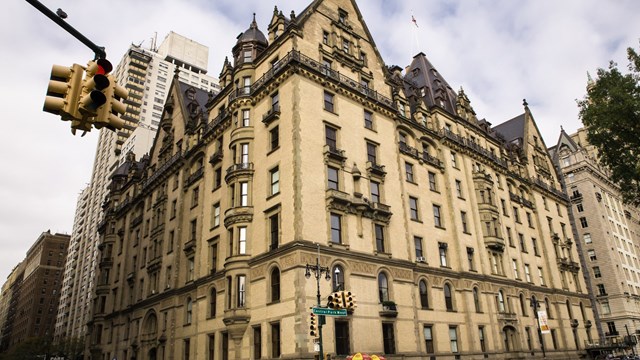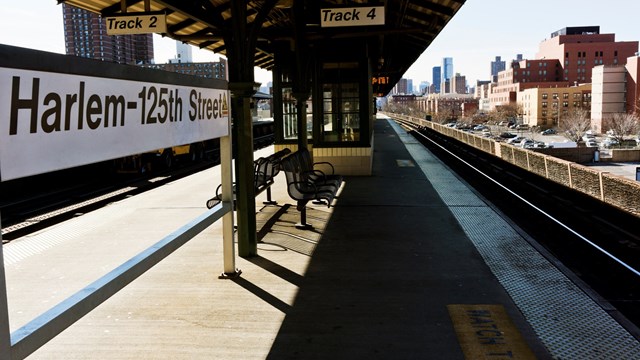Manhattan’s Upper West Side is a repository of striking architecture—it seems like every block features a different, breathtaking example of residential construction. One of these is the Park Royal, located on 73rd Street between Columbus Avenue and Central Park West. A co-op since 1985, the building has twice been named one of the top ten most desirable co-ops in the city.
An Apartment Hotel
The Park Royal was originally designed as an innovation in New York City living—the apartment hotel.
After the turn of the last century, from the time of the construction of the Dakota (which is just down the block from the Park Royal) through the Golden Age of luxury apartment building in the 1920’s and 30’s, developers faced a challenge. As space became more and more of a premium and the economics of the city changed, developers had to sell the idea of apartment living to New Yorkers—many very wealthy—who had previously lived in private homes.
One of the aims of buildings like the Dakota, for example, was to lure people not only to the Upper West Side, but out of their townhouses, says Victor Principe of Prudential Douglas Elliman. The key was making apartments feel more like houses…or mansions. “When you walk into these apartments,” says Principe, “you feel like you are walking into a home.”
The Park Royal also offered something different. The George F. Pelham-designed building offered all the conveniences of a hotel, yet each resident could individually design their own home. Occupants also enjoyed full-time maid service, which was in fact part of each lease—releasing the owner of cleaning and other domestic duties.
To protect the views of Central Park and what used to be the Dakota Gardens, the Park Royal’s developer, Lapidus Engineering Corporation, sought to insure that the views would not be obstructed by future construction by purchasing the brownstones on either side of the Park Royal. These brownstones have since become privately owned.
One of the most attractive features of the building is its stunning lobby, with marble floors and a tremendous crystal chandelier. Outside, the first two floors are limestone, and the upper floors are constructed of gold colored tapestry brick.
Apartments at the Park Royal were divided into two-, three-, and four-room suites on 15 floors. Bedrooms were each equipped with their own private baths.
The kitchens were originally equipped with complete serving pantries with refrigeration and circulating ice water. In addition to the individual kitchens, the Park Royal had a restaurant on the first floor of the building with top-notch cuisine. There was also a theater for live performances on the penthouse level. These amenities separated the building from the other major apartment buildings going up in the area.
“It was a huge success in the 1920’s through the 50’s,” says Joni Slavit, current president of the Park Royal’s board. “The clientele was not transient [as in a hotel], as one had to sign a lease to live here—so in that sense it was not like a normal hotel at all. After the 1950’s however, that type of living was no longer in demand and the building went through a few incarnations before it was converted [to co-op] in 1985.”
The Neighborhood
Although not a landmarked building itself, the Park Royal is located on a landmarked street. It is steps away from Central Park and 73rd Street enters the park at Strawberry Fields, one of its most beautiful and famous locations. This area of quiet introspection is the site of the famous “Imagine” tile homage to the memory of John Lennon, who was killed in front of the nearby Dakota. Walking through these quiet lawns leads into the rest of the park, with the Sheep Meadow and the Boathouse just steps away in either direction.
The short walk through the park to the Upper East Side leads to “Museum Mile,” a stretch of Fifth Avenue where one can find the Metropolitan Museum of Art, the Guggenheim, and the Jewish Museum. The Whitney Museum and the Frick Collection are just one street over on Madison Avenue.
Without leaving the neighborhood, however, residents can walk to the American Museum of Natural History or the New York Historical Society, which are both a few short blocks up Central Park West.
Central Park is not the only park available to residents of the Park Royal. Riverside Park is just a few blocks to the west, and many residents say they actually prefer it to its more famous relative. Riverside is a favorite for those who like to stroll along the marina and the water of the Hudson River. Bikers, rollerbladers, and dog walkers make good use of this strip of land between the river and the West Side Highway. Often less crowded than Central Park, Riverside hosts its own unique flavor.
There are many markets in the neighborhood to choose from as well— everything from Food Emporium and Gristedes to Fairway and Zabar’s. The new shops at Time Warner Center have recently granted a commercial boon to the Upper West Side and Columbus Circle. This geographical center of the island of Manhattan, which has been under endless construction for the last several years, seems to have found a respite, complete with fountains and benches for enjoying a moment in the center of a rotary.
There are countless restaurants and bars throughout the neighborhood as well, and if shopping is a priority, there is an enormous array of clothing and boutique stores on Columbus Avenue and Broadway.
And speaking of Broadway, if culture is on the menu, there are many opportunities to take in a live performance on the Upper West Side. The summer sees a host of festivals in Central Park—everything from free performances at Summerstage and classic theater at the Delacorte, to the roller derby that happens every weekend between Sheep Meadow and Bethesda Fountain. The Beacon and Promenade theaters also host traveling concerts and original plays.
Lincoln Center, the world-class performance center is also located on the Upper West Side, within walking distance from the Park Royal. Whether an opera at the Met or City Opera, City Ballet or American Ballet Theater, or the latest classical musician sensation at Alice Tully Hall, culture lovers can find something to suit their tastes here. In summer the Mostly Mozart festival carries a lively schedule of performances, from swing and salsa dancing to a night of Irish jigs.
Quiet residential blocks comprise the streets of most of the Upper West Side, making it a jogger’s dream. The tree-lines streets of brownstones and apartment complexes make up blocks of idyllic city living, just a short trip from downtown.
The Park Royal Today
Apartments in the Park Royal today are in high demand. The location, amenities, the beautiful lobby, the personable staff, and the excellent condition of the building and its finances make it a sought-after residence. Currently, there are 234 apartments in the building. Studios are typically priced around $400,000 and one-bedroom apartments are around $700,000, says Slavit. Two-bedroom apartments slip past the million-dollar mark, around $1.4 million. These average prices depend on the condition of the apartment and whether or not there is a terrace or other special feature.
Today, the Park Royal is guided by its board, which consists of Slavit, vice-presidents Mitchell Jacobs and Irwin Alberstat, treasurer David Markowitz, and resident manager Neil Zee.
Getting approved by the Park Royal board is not as tricky as it might be with the strict Upper East Side boards, but not just anyone can waltz in and buy an apartment. Slavit characterizes the board’s admission standards as middle-of-the-road. With a few famous residents, the building is home to a very mixed population: working single people, families, and the elderly. “The past ten years have seen a big increase in younger purchasers and young couples,” says Slavit. “We’ve had a major baby boom in the building.”
The building has also seen its share of ups and downs. Around five years ago, a litigious board was in place and the building was nearly bankrupted. The shareholders banded together and the courts removed those board members. “Things are steadily improving,” says Slavit. “The residents are very happy here, and I believe that sentiment would be unanimous.”
One of the benefits of the new board is a new system of communication between the board and the residents. Instead of the impersonal system of gruff memos that had previously been used, Slavit and the new board instituted a building newsletter, the Park Royal Reporter.
“We are able to communicate in a more positive way with our residents because we include items about new residents alongside reminders of house rules and other pertinent information,” says Slavit. “The residents seem to like the newsletter—especially when we include photos of the children at Halloween and pictures of new residents.”
The board at the Park Royal has worked hard over the past five years to correct the damage done by the previous board, says Slavit. “Our hard work has paid off, and we are on a very even keel with all major issues behind us. Now it is a matter of ensuring we keep our finances solid, and our building in good physical condition and well staffed. The hallway project is our major focus now.”
Buildings require upkeep, and sometimes that may mean large capital projects. At The Park Royal, contracts have recently been signed for a new hallway renovation, a million-dollar project.
Like any other building, the Park Royal has seen its share of drama and intrigue over the years—but today, with a solid board in place and a beautiful neighborhood to call home, the building is well-suited to its place among the Upper West Side’s historic treasures.
Denton Tarver is a freelance writer living in New York City.






3 Comments
Leave a Comment